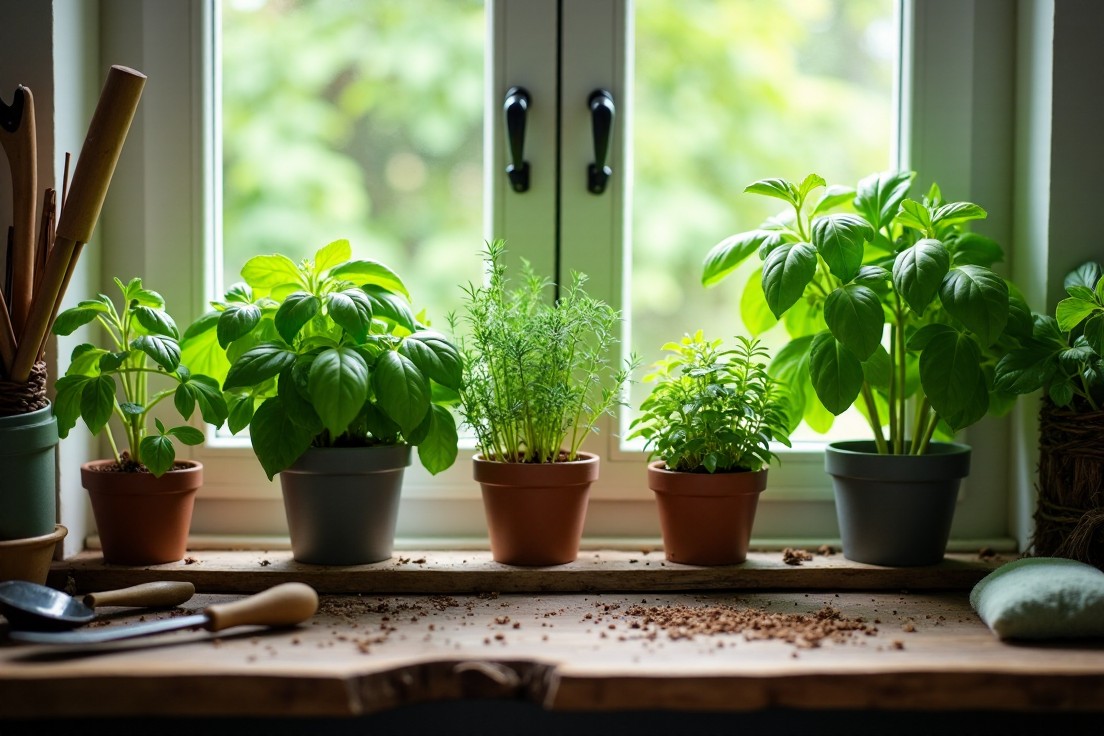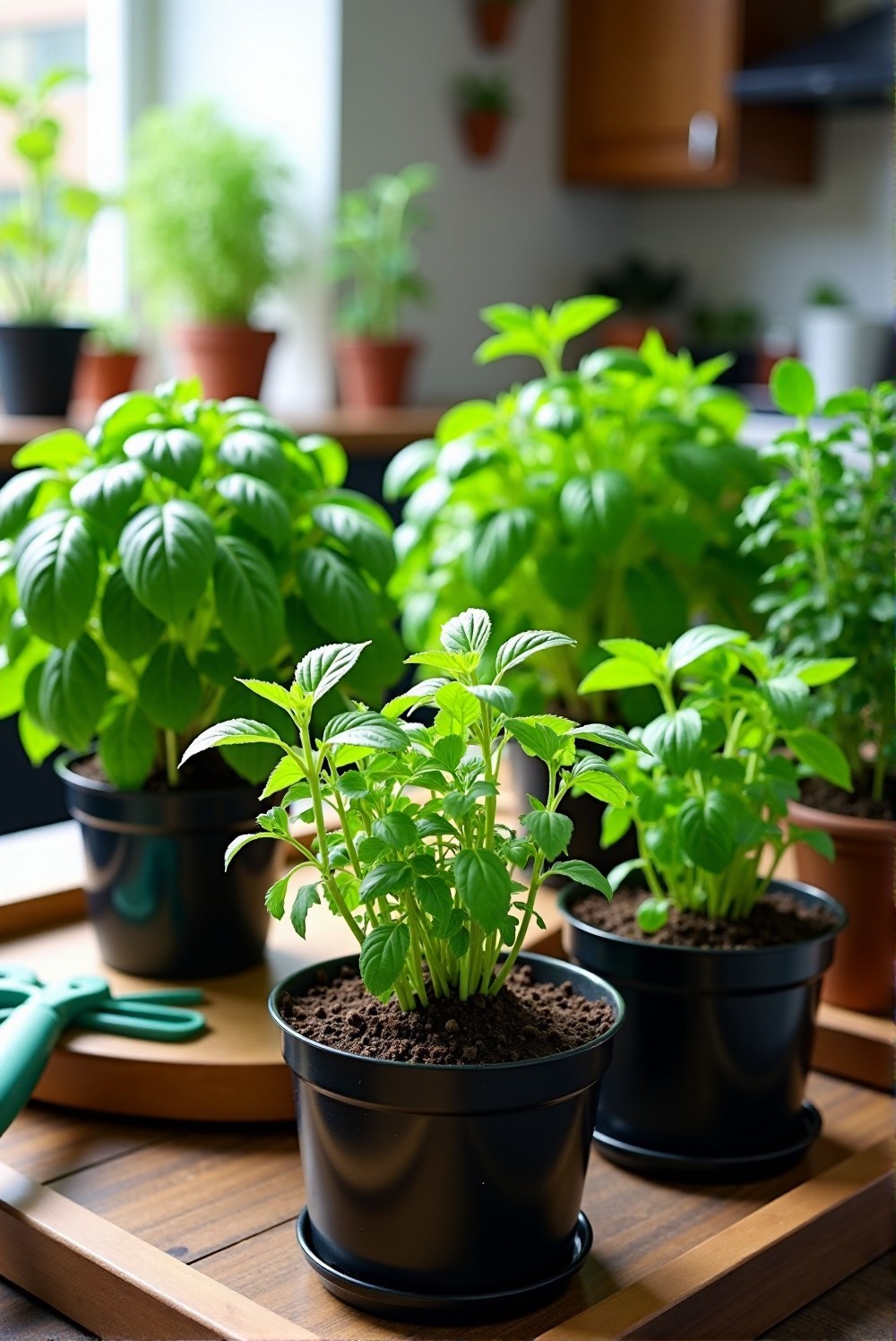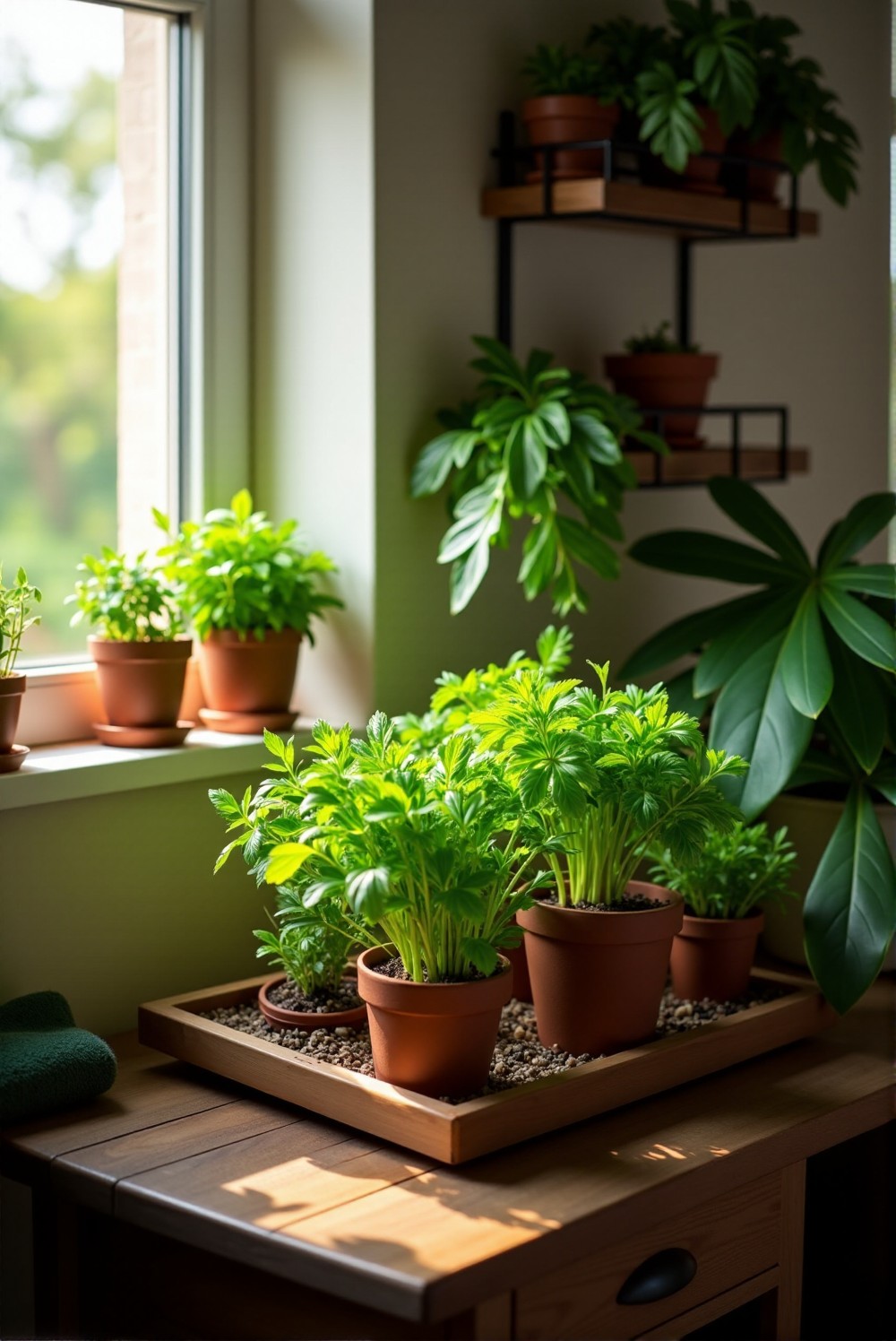
Indoor herb gardening is easier than you might think, and you don’t need a lot of space to get started. With just a few simple steps, you can create a thriving garden right in your kitchen or living room.
Let’s explore how to pick the right herbs, choose suitable containers, and set up the perfect lighting for your new indoor garden.
1. Choose The Right Herbs

When starting your indoor herb garden, selecting the right herbs is essential. Consider your cooking habits and preferences.
If you often use certain herbs, those should be your top picks. Basil, parsley, and cilantro are popular choices because they add great flavor to many dishes.
Next, think about how much sunlight your space receives. Some herbs thrive in bright light, while others do better in lower light conditions.
For instance, mint and chives can grow in indirect light, making them suitable for shadier spots.
It’s also important to pick herbs you will enjoy taking care of.
Some varieties, like rosemary and thyme, are not only useful but also quite hardy. They can tolerate periods of forgetting to water them, which makes them great for beginners.
Finally, consider growing a mix of culinary and aromatic herbs. Culinary herbs enhance your cooking, while aromatic herbs can make your space smell lovely.
A combination can provide both practical uses and a pleasant experience in your home.
2. Select Appropriate Containers

Choosing the right containers is crucial for your indoor herb garden. Consider size first.
When planning your indoor herb garden, selecting the right containers is essential for healthy growth. Here are some important factors to consider when choosing the size of your pots:
- Choose pots that offer adequate depth for root development.
- Consider the growth potential of the herbs larger plants may need bigger containers.
- Ensure containers have proper drainage holes to prevent overwatering.
- Think about the available space and how many herbs you want to grow.
- Use lightweight materials for ease of movement and rearrangement if needed.
Herbs need space to grow, so select pots that are deep enough for the root systems. A container that holds at least 6 to 8 inches of soil is often a good choice for most herbs.
Material plays a big role too. Clay or terracotta pots are excellent as they allow for good air circulation and drainage.
Plastic containers can also work, but ensure they have drainage holes to prevent water from pooling at the bottom.
Think about the shape of the container.
Wider pots are helpful for spreading roots and can be more stable. However, if you have limited space, using tall, narrow containers can maximize vertical space.
Additionally, consider how you want to display your garden. Hanging pots or shelves can add visual appeal and save counter space.
Choose pots that fit your style and the decor of your home, making your garden not just practical but also beautiful.
Lastly, don’t forget to check the weight of the containers.
If you plan to move them around, lightweight options will make that easier. Remember, the right containers can boost your herb-growing success while also adding charm to your space.
Choosing the right containers for your herb garden is essential for both mobility and aesthetics. Below is a table outlining various container types, their weights, and additional features to consider.
| Container Type | Weight (lbs) | Material | Drainage | Style |
|---|---|---|---|---|
| Plastic Pot | 1.5 | Plastic | Yes | Modern |
| Clay Pot | 5 | Terracotta | Yes | Rustic |
| Wooden Box | 3 | Wood | Yes | Country |
| Ceramic Planter | 4 | Ceramic | Yes | Elegant |
| Fabric Grow Bag | 0.5 | Fabric | Yes | Eco-friendly |
| Hanging Basket | 2 | Woven | Yes | Charming |
3. Set Up Optimal Lighting

Proper lighting is key to the success of your indoor herb garden. Herbs typically require around 12 to 16 hours of light each day to thrive.
If your living space doesn’t get enough natural light, consider using grow lights. These can mimic sunlight and provide the necessary energy for plant growth.
LED grow lights are a popular choice because they are energy efficient and produce low heat. Mount them above your herbs at a distance of 6 to 12 inches to prevent burning the leaves.
Adjust the height as your plants grow taller to ensure they receive adequate light.
When positioning your containers, make sure they are placed to receive as much light as possible.
Rotate your plants every few days to ensure all sides get equal exposure to light. This will help them grow evenly and prevent them from leaning toward the light source.
Keep an eye on your herbs. If they start to look leggy or their colors fade, it may be a sign they need more light.
Proper lighting will promote healthy growth and vibrant flavors in your herbs, making your indoor garden more enjoyable and productive.
Frequently Asked Questions
Welcome to our FAQ section on creating an indoor herb garden! Here, we address common questions to help you successfully grow herbs in your home.
What are the best herbs to start with for an indoor garden?
When starting an indoor herb garden, choosing the right herbs is crucial for success. Popular choices include basil, parsley, and cilantro, as they complement many dishes and are commonly used in home cooking.
Additionally, take into account the amount of sunlight your space receives. Some herbs, like mint and chives, thrive in indirect light, making them excellent choices for shadier areas.
Lastly, pick herbs that you enjoy cultivating and using in your meals to enhance both your gardening experience and your cooking.
How do I choose the right containers for my herbs?
Selecting appropriate containers is vital for the growth of your indoor herbs. Consider the size of the pots; they should provide enough depth for healthy root development.
Ensure that you choose pots with drainage holes to prevent any water-related issues and to promote proper air circulation.
Lastly, think about the design and weight of the containers. Lightweight materials like plastic might be easier to move, while clay or terracotta pots can provide a rustic aesthetic.
What lighting is necessary for my indoor herb garden?
Lighting is a key factor for the success of your indoor herb garden. Generally, herbs require around 12 to 16 hours of light each day to thrive.
If natural light is limited, consider using energy-efficient LED grow lights to mimic sunlight. Position these lights about 6 to 12 inches above the herbs to avoid burning the leaves.
Make sure to rotate your plants regularly, allowing all sides to get equal light exposure, which will help promote even growth and prevent leaning.
How often should I water my indoor herbs?
Watering frequency can vary based on the herbs you choose and their growing conditions. Generally, it’s best to water your herbs when the top inch of the soil feels dry to the touch to prevent overwatering.
Make sure not to let the water pool at the bottom of the containers as this can lead to root rot. Always check individual plant needs as some may require more water than others.
Can I grow herbs indoors all year round?
Yes, you can grow herbs indoors throughout the year, making it a convenient option for fresh ingredients. However, you must ensure they receive adequate light and proper care, especially during the winter months when natural light is less available.
Using grow lights can help maintain a healthy growing environment during these periods. Additionally, managing humidity and temperature levels is crucial for herb health.
What are some tips for maintaining my indoor herb garden?
To maintain a flourishing indoor herb garden, consistent care is essential. Keep an eye out for any signs of pests or diseases, as early detection will allow you to address issues promptly.
Regularly prune and harvest the herbs to encourage bushier growth and prevent them from becoming leggy. Remember to rotate your plants and provide adequate light to promote even growth.
What are the benefits of growing herbs indoors?
Growing herbs indoors offers numerous benefits, including having fresh ingredients readily available for cooking. They can enhance the flavors of your meals while also adding nutritional value.
An indoor herb garden can improve air quality and add a pleasant aroma to your living space. Furthermore, caring for your plants can be a relaxing and fulfilling hobby, providing a sense of accomplishment.
Conclusion
Creating an indoor herb garden can be a fun and rewarding project. By choosing the right herbs, selecting suitable containers, and providing optimal lighting, you can enjoy fresh flavors in your cooking throughout the year.
Remember, even if you’re new to gardening, taking these three easy steps can lead to success. With a little care and attention, your indoor herbs will thrive and bring a touch of nature into your home.
Enjoy the process and happy gardening!